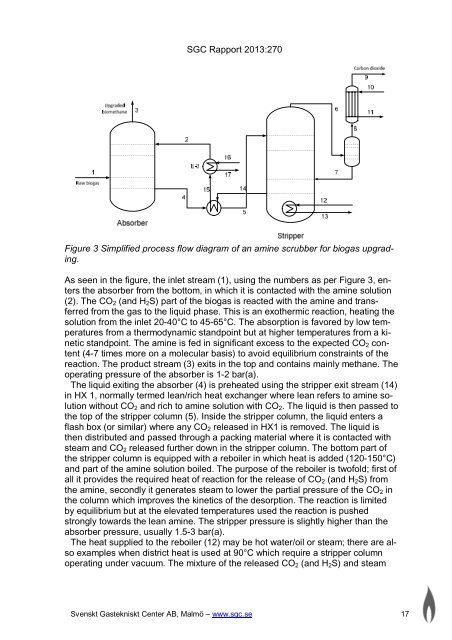Biogas upgrading – Review of commercial technologies - SGC
Biogas upgrading – Review of commercial technologies - SGC
Biogas upgrading – Review of commercial technologies - SGC
Create successful ePaper yourself
Turn your PDF publications into a flip-book with our unique Google optimized e-Paper software.
<strong>SGC</strong> Rapport 2013:270<br />
Figure 3 Simplified process flow diagram <strong>of</strong> an amine scrubber for biogas <strong>upgrading</strong>.<br />
As seen in the figure, the inlet stream (1), using the numbers as per Figure 3, enters<br />
the absorber from the bottom, in which it is contacted with the amine solution<br />
(2). The CO2 (and H2S) part <strong>of</strong> the biogas is reacted with the amine and transferred<br />
from the gas to the liquid phase. This is an exothermic reaction, heating the<br />
solution from the inlet 20-40°C to 45-65°C. The absorption is favored by low temperatures<br />
from a thermodynamic standpoint but at higher temperatures from a kinetic<br />
standpoint. The amine is fed in significant excess to the expected CO2 content<br />
(4-7 times more on a molecular basis) to avoid equilibrium constraints <strong>of</strong> the<br />
reaction. The product stream (3) exits in the top and contains mainly methane. The<br />
operating pressure <strong>of</strong> the absorber is 1-2 bar(a).<br />
The liquid exiting the absorber (4) is preheated using the stripper exit stream (14)<br />
in HX 1, normally termed lean/rich heat exchanger where lean refers to amine solution<br />
without CO2 and rich to amine solution with CO2. The liquid is then passed to<br />
the top <strong>of</strong> the stripper column (5). Inside the stripper column, the liquid enters a<br />
flash box (or similar) where any CO2 released in HX1 is removed. The liquid is<br />
then distributed and passed through a packing material where it is contacted with<br />
steam and CO2 released further down in the stripper column. The bottom part <strong>of</strong><br />
the stripper column is equipped with a reboiler in which heat is added (120-150°C)<br />
and part <strong>of</strong> the amine solution boiled. The purpose <strong>of</strong> the reboiler is tw<strong>of</strong>old; first <strong>of</strong><br />
all it provides the required heat <strong>of</strong> reaction for the release <strong>of</strong> CO2 (and H2S) from<br />
the amine, secondly it generates steam to lower the partial pressure <strong>of</strong> the CO2 in<br />
the column which improves the kinetics <strong>of</strong> the desorption. The reaction is limited<br />
by equilibrium but at the elevated temperatures used the reaction is pushed<br />
strongly towards the lean amine. The stripper pressure is slightly higher than the<br />
absorber pressure, usually 1.5-3 bar(a).<br />
The heat supplied to the reboiler (12) may be hot water/oil or steam; there are also<br />
examples when district heat is used at 90°C which require a stripper column<br />
operating under vacuum. The mixture <strong>of</strong> the released CO2 (and H2S) and steam<br />
Svenskt Gastekniskt Center AB, Malmö <strong>–</strong> www.sgc.se 17

















